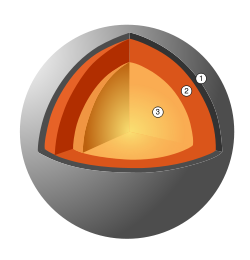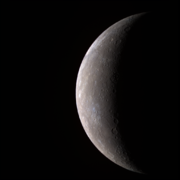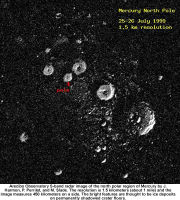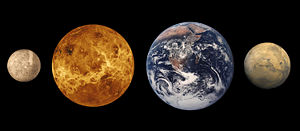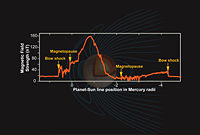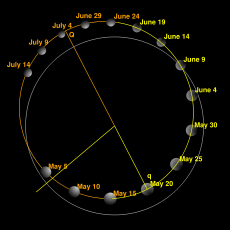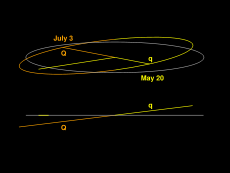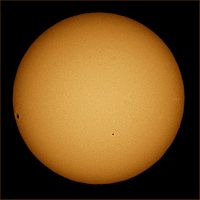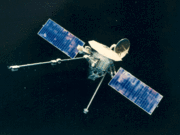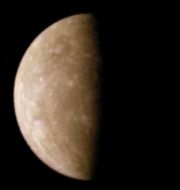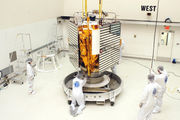Mercury (planet)
2008/9 Schools Wikipedia Selection. Related subjects: The Planets
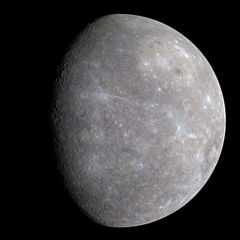 MESSENGER false colour image of Mercury
|
||||||||||
|
Designations
|
||||||||||
|---|---|---|---|---|---|---|---|---|---|---|
| Adjective | Mercurian, Mercurial | |||||||||
|
Orbital characteristics
|
||||||||||
| Epoch J2000 | ||||||||||
| Aphelion | 69,816,900 km 0.466697 AU |
|||||||||
| Perihelion | 46,001,200 km 0.307499 AU |
|||||||||
| Semi-major axis | 57,909,100 km 0.387098 AU |
|||||||||
| Eccentricity | 0.205630 | |||||||||
| Orbital period | 87.9691 d (0.240846 a) |
|||||||||
| Synodic period | 115.88 d | |||||||||
| Average orbital speed | 47.87 km/s | |||||||||
| Mean anomaly | 174.796° | |||||||||
| Inclination | 7.005° 3.38° to Sun’s equator |
|||||||||
| Longitude of ascending node | 48.331° | |||||||||
| Argument of perihelion | 29.124° | |||||||||
| Satellites | None | |||||||||
|
Physical characteristics
|
||||||||||
| Mean radius | 2,439.7 ± 1.0 km 0.3829 Earths |
|||||||||
| Flattening | < 0.0006 | |||||||||
| Surface area | 7.48×107 km² 0.108 Earths |
|||||||||
| Volume | 6.083×1010 km³ 0.054 Earths |
|||||||||
| Mass | 3.3022×1023 kg 0.055 Earths |
|||||||||
| Mean density | 5.427 g/cm³ | |||||||||
| Equatorial surface gravity | 3.7 m/s² 0.38 g |
|||||||||
| Escape velocity | 4.25 km/s | |||||||||
| Sidereal rotation period |
58.646 day 1407.5 h |
|||||||||
| Equatorial rotation velocity | 10.892 km/h | |||||||||
| Axial tilt | 2.11′ ± 0.1′ | |||||||||
| North pole right ascension | 18 h 44 min 2 s 281.01° |
|||||||||
| North pole declination | 61.45° | |||||||||
| Albedo | 0.119 ( bond) 0.106 ( geom.) |
|||||||||
| Surface temp. 0°N, 0°W 85°N, 0°W |
|
|||||||||
| Apparent magnitude | up to −1.9 | |||||||||
| Angular diameter | 4.5" – 13" | |||||||||
|
Atmosphere
|
||||||||||
| Surface pressure | trace | |||||||||
| Composition | 42% Molecular oxygen 29.0% sodium 22.0% hydrogen 6.0% helium 0.5% potassium Trace amounts of argon, nitrogen, carbon dioxide, water vapor, xenon, krypton, & neon |
|||||||||
Mercury (pronounced [ˈmɝkjʊəri] ) is the innermost and smallest planet in the solar system (since Pluto was re-labelled as a dwarf planet), orbiting the Sun once every 88 days. Mercury is bright when viewed from Earth, ranging from −2.0 to 5.5 in apparent magnitude, but is not easily seen as its greatest angular separation from the Sun (greatest elongation) is only 28.3°: It can only be seen in morning and evening twilight. Comparatively little is known about it; the first of two spacecraft to approach Mercury was Mariner 10 from 1974 to 1975, which mapped only about 45% of the planet’s surface. The second was the MESSENGER spacecraft, which mapped another 30% of the planet during its flyby of January 14, 2008. MESSENGER will make two more passes by Mercury, followed by orbital insertion in 2011, and will survey and map the entire planet.
Physically, Mercury is similar in appearance to the Moon. It is heavily cratered, has no natural satellites and no substantial atmosphere. It has a large iron core, which generates a magnetic field about 1% as strong as that of the Earth. It is an exceptionally dense planet due to the large size of its core. The surface temperatures on Mercury range from about 90 to 700 K (-183 ºC to 427 ºC), with the subsolar point being the hottest and the bottoms of craters near the poles being the coldest.
Recorded observations of Mercury date back to at least the first millennium BC. Before the 4th century BC, Greek astronomers believed the planet to be two separate objects: one visible only at sunrise, which they called Apollo; the other visible only at sunset, which they called Hermes. The English name for the planet comes from the Romans, who named it after the Roman god Mercury, which they equated with the Greek Hermes. The astronomical symbol for Mercury is a stylized version of Hermes' caduceus.
Internal structure
Mercury is one of four terrestrial planets, and is a rocky body like the Earth. It is the smallest planet in the solar system, with an equatorial radius of 2439.7 km. Mercury is even smaller—albeit more massive—than the largest natural satellites in the solar system, Ganymede and Titan. Mercury consists of approximately 70% metallic and 30% silicate material. Mercury's density is the second highest in the Solar System at 5.427 g/cm³, only slightly less than Earth’s density of 5.515 g/cm³. If the effect of gravitational compression were to be factored out, the materials of which Mercury is made would be denser, with an uncompressed density of 5.3 g/cm³ versus Earth’s 4.4 g/cm³.
Mercury’s density can be used to infer details of its inner structure. While the Earth’s high density results appreciably from gravitational compression, particularly at the core, Mercury is much smaller and its inner regions are not nearly as strongly compressed. Therefore, for it to have such a high density, its core must be large and rich in iron. Geologists estimate that Mercury’s core occupies about 42% of its volume; for Earth this proportion is 17%. Recent research strongly suggests Mercury has a molten core.
Surrounding the core is a 600 km mantle. It is generally thought that early in Mercury’s history, a giant impact with a body several hundred kilometers across stripped the planet of much of its original mantle material, resulting in the relatively thin mantle compared to the sizable core.
Based on data from the Mariner 10 mission and Earth-based observation, Mercury’s crust is believed to be 100–300 km thick. One distinctive feature of Mercury’s surface is the presence of numerous narrow ridges, some extending over several hundred kilometers. It is believed that these were formed as Mercury’s core and mantle cooled and contracted at a time when the crust had already solidified.
Mercury's core has a higher iron content than that of any other major planet in the Solar System, and several theories have been proposed to explain this. The most widely accepted theory is that Mercury originally had a metal-silicate ratio similar to common chondrite meteors, thought to be typical of the Solar System's rocky matter, and a mass approximately 2.25 times its current mass. However, early in the solar system’s history, Mercury may have been struck by a planetesimal of approximately 1/6 that mass. The impact would have stripped away much of the original crust and mantle, leaving the core behind as a relatively major component. A similar process has been proposed to explain the formation of Earth’s Moon (see giant impact theory).
Alternatively, Mercury may have formed from the solar nebula before the Sun’s energy output had stabilized. The planet would initially have had twice its present mass, but as the protosun contracted, temperatures near Mercury could have been between 2,500 and 3,500 K, (2,227 ºC to 3,227 ºC) and possibly even as high as 10,000 K (9,727 ºC). Much of Mercury’s surface rock could have been vaporized at such temperatures, forming an atmosphere of "rock vapor" which could have been carried away by the solar wind.
A third hypothesis proposes that the solar nebula caused drag on the particles from which Mercury was accreting, which meant that lighter particles were lost from the accreting material. Each of these hypotheses predicts a different surface composition, and two upcoming space missions, MESSENGER and BepiColombo, both aim to make observations to test them.
Surface geology
Mercury’s surface is overall very similar in appearance to that of the Moon, showing extensive mare-like plains and heavy cratering, indicating that it has been geologically inactive for billions of years. Since our knowledge of Mercury's geology has been based on the 1975 Mariner flyby and terrestrial observations, it is the least understood of the terrestrial planets. As data from the recent MESSENGER flyby is processed this knowledge will increase. For example, an unusual crater with radiating troughs has been discovered which scientists are calling "the spider."
Albedo features refer to areas of markedly different reflectivity, as seen by telescopic observation. Mercury also possesses Dorsa (also called " wrinkle-ridges"), Moon-like highlands, Montes (mountains), Planitiae, or plains, Rupes ( escarpments), and Valles ( valleys).
Mercury was heavily bombarded by comets and asteroids during and shortly following its formation 4.6 billion years ago, as well as during a possibly separate subsequent episode called the late heavy bombardment that came to an end 3.8 billion years ago. During this period of intense crater formation, the planet received impacts over its entire surface, facilitated by the lack of any atmosphere to slow impactors down. During this time the planet was volcanically active; basins such as the Caloris Basin were filled by magma from within the planet, which produced smooth plains similar to the maria found on the Moon.
Impact basins and craters
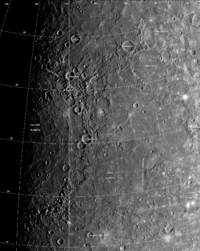
Craters on Mercury range in diameter from small bowl-shaped cavities to multi-ringed impact basins hundreds of kilometers across. They appear in all states of degradation, from relatively fresh rayed craters to highly degraded crater remnants. Mercurian craters differ subtly from lunar craters in that the area blanketed by their ejecta is much smaller, a consequence of Mercury's stronger surface gravity.
The largest known craters are Caloris Basin, with a diameter of 1550 km, and the Skinakas Basin with an outer-ring diameter of 2,300 km. The impact that created the Caloris Basin was so powerful that it caused lava eruptions and left a concentric ring over 2 km tall surrounding the impact crater. At the antipode of the Caloris Basin is a large region of unusual, hilly terrain known as the "Weird Terrain". One hypothesis for its origin is that shock waves generated during the Caloris impact traveled around the planet, converging at the basin’s antipode (180 degrees away). The resulting high stresses fractured the surface. Alternatively, it has been suggested that this terrain formed as a result of the convergence of ejecta at this basin’s antipode.
Overall, about 15 impact basins have been identified on the imaged part of Mercury. Other notable basins include the 400 km wide, multi-ring, Tolstoj Basin which has an ejecta blanket extending up to 500 km from its rim, and its floor has been filled by smooth plains materials. Beethoven Basin also has a similar-sized ejecta blanket and a 625 km diameter rim. Like the Moon, the surface of Mercury has likely incurred the effects of space weathering processes, including Solar wind and micrometeorite impacts.
Plains
There are two geologically distinct plains regions on Mercury. Gently rolling, hilly plains in the regions between craters are Mercury's oldest visible surfaces, predating the heavily cratered terrain. The inter-crater plains appear to have obliterated many earlier craters, and show a general paucity of smaller craters below about 30 km in diameter. It is not clear whether they are of volcanic or impact origin. The inter-crater plains are distributed roughly uniformly over the entire surface of the planet.
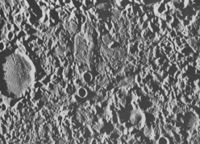
Smooth plains are widespread flat areas which fill depressions of various sizes and bear a strong resemblance to the lunar maria. Notably, they fill a wide ring surrounding the Caloris Basin. An appreciable difference between these plains and lunar maria is that the smooth plains of Mercury have the same albedo as the older inter-crater plains. Despite a lack of unequivocally volcanic characteristics, the localisation and rounded, lobate shape of these plains strongly support volcanic origins. All the Mercurian smooth plains formed significantly later than the Caloris basin, as evidenced by appreciably smaller crater densities than on the Caloris ejecta blanket. The floor of the Caloris Basin is also filled by a geologically distinct flat plain, broken up by ridges and fractures in a roughly polygonal pattern. It is not clear whether they are volcanic lavas induced by the impact, or a large sheet of impact melt.
One unusual feature of the planet’s surface is the numerous compression folds, or rupes, which crisscross the plains. It is thought that as the planet’s interior cooled, it contracted and its surface began to deform. The folds can be seen on top of other features, such as craters and smoother plains, indicating that they are more recent. Mercury’s surface is also flexed by significant tidal bulges raised by the Sun—the Sun’s tides on Mercury are about 17 times stronger than the Moon’s on Earth.
Surface conditions and "atmosphere" (exosphere)
The mean surface temperature of Mercury is 442.5 K, but it ranges from 100 K to 700 K, due to the absence of an atmosphere. On the dark side of the planet, temperatures average 110 K. The intensity of sunlight on Mercury’s surface ranges between 4.59 and 10.61 times the solar constant (1370Wm−2).
Despite the generally extremely high temperature of its surface, observations strongly suggest that ice exists on Mercury. The floors of some deep craters near the poles are never exposed to direct sunlight, and temperatures there remain far lower than the global average. Water ice strongly reflects radar, and observations by the 70m Goldstone telescope and the VLA in the early 1990s revealed that there are patches of very high radar reflection near the poles. While ice is not the only possible cause of these reflective regions, astronomers believe it is the most likely.
The icy regions are believed to be covered to a depth of only a few meters, and contain about 1014–1015 kg of ice. By comparison, the Antarctic ice sheet on Earth has a mass of about 4×1018 kg, and Mars’ south polar cap contains about 1016 kg of water. The origin of the ice on Mercury is not yet known, but the two most likely sources are from outgassing of water from the planet’s interior or deposition by impacts of comets.
Mercury is too small for its gravity to retain any significant atmosphere over long periods of time; however, it does have a "tenuous surface-bounded exosphere" containing hydrogen, helium, oxygen, sodium, calcium and potassium. This exosphere is not stable—atoms are continuously lost and replenished from a variety of sources. Hydrogen and helium atoms probably come from the solar wind, diffusing into Mercury’s magnetosphere before later escaping back into space. Radioactive decay of elements within Mercury’s crust is another source of helium, as well as sodium and potassium. Water vapor is present, being brought to Mercury by some combination of processes such as: comets striking its surface, sputtering creating water "where none existed before from the ingredients of solar wind and Mercury rock" (both contain hydrogen and oxygen), and "reservoirs of water ice in small areas of Mercury's poles where local topography creates permanently shadowed spots in crater walls that might trap water over the age of the solar system". MESSENGER found high proportions of calcium, helium, hydroxide, magnesium, oxygen, potassium, silicon, sodium, and water. The detection of high amounts of water-related ions like O+, OH-, and H2O+ was a surprise. Because of the quantities of these ions that were detected in Mercury's space environment, scientists surmise that these molecules were blasted from the surface or exosphere by the solar wind.
Sodium and potassium were discovered in the atmosphere during the 1980s, and are believed to result primarily from the vaporization of surface rock struck by micrometeorite impacts. Due to the ability of these materials to diffuse sunlight, Earth-based observers can readily detect their composition in the atmosphere. Studies indicate that, at times, Sodium emissions are localized at points that correspond to the planet's magnetic dipoles. This would indicate some interaction between the magnetosphere and the planet's surface.
Magnetic field and magnetosphere
Despite its small size and slow 59-day-long rotation, Mercury has a significant, and apparently global, magnetic field. According to measurements taken by Mariner 10, it is about 1.1% as strong as the Earth’s. The magnetic field strength at the Mercurian equator is about 300 nT. Like that of Earth, Mercury's magnetic field is dipolar in nature. Unlike Earth, however, Mercury's poles are nearly aligned with the planet's spin axis. Measurements from both the Mariner 10 and MESSENGER space probes have indicated that the strength and shape of the magnetic field are stable.
It is likely that this magnetic field is generated by way of a Dynamo effect, in a manner similar to the magnetic field of Earth. This dynamo effect would result from the circulation of the planet's iron-rich liquid core. Particularly strong tidal effects caused by the planet's high orbital eccentricity would serve to keep the core in the liquid state necessary for this dynamo effect.
Mercury’s magnetic field is strong enough to deflect the solar wind around the planet, creating a magnetosphere. The planet's magnetosphere, though small enough to fit within the Earth, is strong enough to trap solar wind plasma. This contributes to the space weathering of the planet's surface. Observations taken by the Mariner 10 spacecraft detected this low energy plasma in the magnetosphere of the planet's nightside. Bursts of energetic particles were detected in the planet's magnetotail, which indicates a dynamic quality to the planet's magnetosphere.
Orbit and rotation
Mercury has the most eccentric orbit of all the planets; its eccentricity is 0.21 with its distance from the Sun ranging from 46,000,000 to 70,000,000 kilometers. It takes 88 days to complete an orbit. The diagram on the left illustrates the effects of the eccentricity, showing Mercury’s orbit overlaid with a circular orbit having the same semi-major axis. The higher velocity of the planet when it is near perihelion is clear from the greater distance it covers in each 5-day interval. The size of the spheres, inversely proportional to their distance from the Sun, is used to illustrate the varying heliocentric distance. This varying distance to the Sun, combined with a 3:2 spin-orbit resonance of the planet’s rotation around its axis, result in complex variations of the surface temperature.
Mercury’s orbit is inclined by 7° to the plane of Earth’s orbit (the ecliptic), as shown in the diagram on the right. As a result, transits of Mercury across the face of the Sun can only occur when the planet is crossing the plane of the ecliptic at the time it lies between the Earth and the Sun. This occurs about every seven years on average.
Functionally, Mercury’s axial tilt is nonexistent, with measurements as low as 0.027°. This is significantly smaller than that of Jupiter, which boasts the second smallest axial tilt of all planets at 3.1 degrees. This means an observer at Mercury’s equator during local noon would never see the Sun more than approximately 1/30 of one degree north or south of the zenith. Conversely, at the poles the Sun never rises more than 2.1′ above the horizon.
At certain points on Mercury’s surface, an observer would be able to see the Sun rise about halfway, then reverse and set before rising again, all within the same Mercurian day. This is because approximately four days prior to perihelion, Mercury’s angular orbital velocity exactly equals its angular rotational velocity so that the Sun’s apparent motion ceases; at perihelion, Mercury’s angular orbital velocity then exceeds the angular rotational velocity. Thus, the Sun appears to move in a retrograde direction. Four days after perihelion, the Sun’s normal apparent motion resumes at these points.
Advance of perihelion
During the 19th century, French mathematician Le Verrier noticed that the slow precession of Mercury’s orbit around the Sun could not be completely explained by Newtonian mechanics and perturbations by the known planets. He proposed that another planet might exist in an orbit even closer to the Sun to account for this perturbation. (Other explanations considered included a slight oblateness of the Sun.) The success of the search for Neptune based on its perturbations of the orbit of Uranus led astronomers to place great faith in this explanation, and the hypothetical planet was even named Vulcan. However, no such planet was ever found.
In the early 20th century, Albert Einstein’s General Theory of Relativity provided the explanation for the observed precession. The effect is very small: the Mercurian relativistic perihelion advance excess is just 42.98 arcseconds per century, therefore it requires a little over twelve million orbits for a full excess turn. Similar, but much smaller effects, operate for other planets, being 8.62 arcseconds per century for Venus, 3.84 for Earth, 1.35 for Mars, and 10.05 for 1566 Icarus.
Spin–orbit resonance
For many years it was thought that Mercury was synchronously tidally locked with the Sun, rotating once for each orbit and keeping the same face directed towards the Sun at all times, in the same way that the same side of the Moon always faces the Earth. However, radar observations in 1965 proved that the planet has a 3:2 spin–orbit resonance, rotating three times for every two revolutions around the Sun; the eccentricity of Mercury’s orbit makes this resonance stable—at perihelion, when the solar tide is strongest, the Sun is nearly still in Mercury’s sky.
The original reason astronomers thought it was synchronously locked was that whenever Mercury was best placed for observation, it was always at the same point in its 3:2 resonance, hence showing the same face. Due to Mercury’s 3:2 spin–orbit resonance, a solar day (the length between two meridian transits of the Sun) lasts about 176 Earth days. A sidereal day (the period of rotation) lasts about 58.7 Earth days.
Orbital simulations indicate that the eccentricity of Mercury’s orbit varies chaotically from 0 (circular) to a very high 0.47 over millions of years. This is thought to explain Mercury’s 3:2 spin-orbit resonance (rather than the more usual 1:1), since this state is more likely to arise during a period of high eccentricity.
Observation
Mercury’s apparent magnitude varies between about −2.0—brighter than Sirius—and 5.5. Observation of Mercury is complicated by its proximity to the Sun, as it is lost in the Sun’s glare for much of the time. Mercury can be observed for only a brief period during either morning or evening twilight. The Hubble Space Telescope cannot observe Mercury at all, due to safety procedures which prevent its pointing too close to the Sun.
Like the Moon, Mercury exhibits phases as seen from Earth, being "new" at inferior conjunction and “full” at superior conjunction. The planet is rendered invisible on both of these occasions by virtue of its rising and setting in concert with the Sun in each case. The first and last quarter phases occur at greatest elongation east and west, respectively, when Mercury's separation from the Sun ranges anywhere from 17.9° at perihelion to 27.8° at aphelion. At greatest elongation west, Mercury rises earliest before the Sun, and at greatest elongation east, it sets latest after the Sun.
Mercury attains inferior conjunction every 116 days on average, but this interval can range from 111 days to 121 days due to the planet’s eccentric orbit. Mercury can come as close as 77.3 million km to the Earth, but currently it does not come closer than 82 million km from the Earth. Its period of retrograde motion as seen from Earth can vary from 8 to 15 days on either side of inferior conjunction. This large range also arises from the planet’s high orbital eccentricity.
Mercury is more often easily visible from Earth’s Southern Hemisphere than from its Northern Hemisphere; this is because its maximum possible elongations west of the Sun always occur when it is early autumn in the Southern Hemisphere, while its maximum possible eastern elongations happen when the Southern Hemisphere is having its late winter season. In both of these cases, the angle Mercury strikes with the ecliptic is maximized, allowing it to rise several hours before the Sun in the former instance and not set until several hours after sundown in the latter in countries located at southern temperate zone latitudes, such as Argentina and New Zealand. By contrast, at northern temperate latitudes, Mercury is never above the horizon of a more-or-less fully dark night sky. Mercury can also, like several other planets and the brightest stars, be seen during a total solar eclipse.
Mercury is brightest as seen from Earth when it is at a gibbous phase, between either quarter phase and full. Although the planet is further away from Earth when it is gibbous than when it is a crescent, the greater illuminated area visible more than compensates for the greater distance. The opposite is true for Venus, which appears brightest when it is a thin crescent, because it is much closer to Earth than when gibbous.
Studies of Mercury
Ancient astronomers
The earliest known recorded observations of Mercury are from the MUL.APIN tablets. These observations were most likely made by an Assyrian astronomer around the 14th century BC. The cuniform name used to designate Mercury on the MUL.APIN tablets is transcribed as UDU.IDIM.GU4.UD ("the jumping planet"). Babylonian records of Mercury date back to the 1st millennium BC. The Babylonians called the planet Nabu after the messenger to the Gods in their mythology.
The ancient Greeks of Hesiod's time knew the planet as Στίλβων (Stilbon), meaning "the gleaming", and Ἑρμάων (Hermaon). Later Greeks called the planet Apollo when it was visible in the morning sky and Hermes when visible in the evening. Around the 4th century BC, however, Greek astronomers came to understand that the two names referred to the same body. The Romans named the planet after the Roman messenger god, Mercury (Latin Mercurius), which they equated with the Greek Hermes.
In ancient China, Mercury was known as Ch'en-Hsing, the Hour Star. It was associated with the direction north and the phase of water in the Wu Xing. Hindu mythology used the name Budha for Mercury, and this god was thought to preside over Wednesday. The god Odin (or Woden) of Germanic paganism was also associated with the planet Mercury and the name Wednesday was derived from Woden's day. The Maya may have represented Mercury as an owl (or possibly four owls; two for the morning aspect and two for the evening) that served as a messenger to the underworld.
Ground-based telescopic research
The first telescopic observations of Mercury were made by Galileo in the early 17th century. Although he observed phases when he looked at Venus, his telescope was not powerful enough to see the phases of Mercury. In 1631 Pierre Gassendi made the first observations of the transit of a planet across the Sun when he saw a transit of Mercury predicted by Johannes Kepler. In 1639 Giovanni Zupi used a telescope to discover that the planet had orbital phases similar to Venus and the Moon. The observation demonstrated conclusively that Mercury orbited around the Sun.
A very rare event in astronomy is the passage of one planet in front of another ( occultation), as seen from Earth. Mercury and Venus occult each other every few centuries, and the event of May 28, 1737 is the only one historically observed, having been seen by John Bevis at the Royal Greenwich Observatory. The next occultation of Mercury by Venus will be on December 3, 2133.
The difficulties inherent in observing Mercury mean that it has been far less studied than the other planets. In 1800 Johann Schröter made observations of surface features, claiming to observed 20 km high mountains. Friedrich Bessel used Schröter's drawings to erroneously estimate the rotation period as 24 hours and an axial tilt of 70°. In the 1880s Giovanni Schiaparelli mapped the planet more accurately, and suggested that Mercury’s rotational period was 88 days, the same as its orbital period due to tidal locking. This phenomenon is known as synchronous rotation and is also shown by Earth’s Moon. The effort to Map the surface of Mercury was continued by Eugenios Antoniadi, who published a book in 1934 that included both maps and his own observations. Many of the planet's surface features, particularly the albedo features, take their names from Antoniadi's map.
In June 1962 Soviet scientists at the Institute of Radio-engineering and Electronics of the USSR Academy of Sciences lead by Vladimir Kotelnikov became first to bounce radar signal off Mercury and receive it, starting radar observations of the planet. Three years later radar observations by Americans Gordon Pettengill and R. Dyce using 300-meter Arecibo Observatory radio telescope in Puerto Rico showed conclusively that the planet’s rotational period was about 59 days. The theory that Mercury’s rotation was synchronous became widely held, and it was a surprise to astronomers when these radio observations were announced. If Mercury were tidally locked, its dark face would be extremely cold, but measurements of radio emission revealed that it was much hotter than expected. Astronomers were reluctant to drop the synchronous rotation theory and proposed alternative mechanisms such as powerful heat-distributing winds to explain the observations.
Italian astronomer Giuseppe Colombo noted that the rotation value was about two-thirds of Mercury’s orbital period, and proposed that a different form of tidal locking had occurred in which the planet’s orbital and rotational periods were locked into a 3:2 rather than a 1:1 resonance. Data from Mariner 10 subsequently confirmed this view.
Ground-based observations did not shed much further light on the innermost planet, and it was not until space probes visited Mercury that many of its most fundamental properties became known. However, recent technological advances have led to improved ground-based observations. In 2000, high-resolution lucky imaging from the Mount Wilson Observatory 1500 mm telescope provided the first views that resolved some surface features on the parts of Mercury which were not imaged in the Mariner missions. Later imaging has shown evidence of a huge double-ringed impact basin even larger than the Caloris Basin in the non-Mariner-imaged hemisphere. It has informally been dubbed the Skinakas Basin. Most of the planet has been mapped by the Arecibo radar telescope, with 5 km resolution, including polar deposits in shadowed craters of what may be water ice.
Research with space probes
Reaching Mercury from Earth poses significant technical challenges, since the planet orbits so much closer to the Sun than does the Earth. A Mercury-bound spacecraft launched from Earth must travel over 91 million kilometers into the Sun’s gravitational potential well. Starting from the Earth’s orbital speed of 30 km/s, the change in velocity ( delta-v) the spacecraft must make to enter into a Hohmann transfer orbit that passes near Mercury is large compared to other planetary missions.
The potential energy liberated by moving down the Sun’s potential well becomes kinetic energy; requiring another large delta-v change to do anything other than rapidly pass by Mercury. In order to land safely or enter a stable orbit the spacecraft must rely entirely on rocket motors since aerobraking is ruled out because the planet has very little atmosphere. A trip to Mercury actually requires more rocket fuel than that required to escape the solar system completely. As a result, only two space probes have visited the planet so far. A proposed alternative approach would use a solar sail to attain a Mercury-synchronous orbit around the Sun.
Mariner 10
The first spacecraft to visit Mercury was NASA’s Mariner 10 (1974–75). The spacecraft used the gravity of Venus to adjust its orbital velocity so that it could approach Mercury, making it both the first spacecraft to use this gravitational “slingshot” effect and the first NASA mission to visit multiple planets. Mariner 10 provided the first close-up images of Mercury’s surface, which immediately showed its heavily cratered nature, and also revealed many other types of geological features, such as the giant scarps which were later ascribed to the effect of the planet shrinking slightly as its iron core cools. Unfortunately, due to the length of Mariner 10's orbital period, the same face of the planet was lit at each of Mariner 10’s close approaches. This made observation of both sides of the planet impossible, and resulted in the mapping of less than 45% of the planet’s surface.
The spacecraft made three close approaches to Mercury, the closest of which took it to within 327 km of the surface. At the first close approach, instruments detected a magnetic field, to the great surprise of planetary geologists—Mercury’s rotation was expected to be much too slow to generate a significant dynamo effect. The second close approach was primarily used for imaging, but at the third approach, extensive magnetic data were obtained. The data revealed that the planet’s magnetic field is much like the Earth’s, which deflects the solar wind around the planet. However, the origin of Mercury’s magnetic field is still the subject of several competing theories.
Just a few days after its final close approach, Mariner 10 ran out of fuel. Since its orbit could no longer be accurately controlled, mission controllers instructed the probe to shut itself down on March 24, 1975. Mariner 10 is thought to be still orbiting the Sun, passing close to Mercury every few months.
MESSENGER
A second NASA mission to Mercury, named MESSENGER (MErcury Surface, Space ENvironment, GEochemistry, and Ranging), was launched on August 3, 2004, from the Cape Canaveral Air Force Station aboard a Boeing Delta 2 rocket. The MESSENGER spacecraft will make several close approaches to planets to place it onto the correct trajectory to reach an orbit around Mercury. It made a fly-by of the Earth in August 2005, and of Venus in October 2006 and June 2007. The first fly-by of Mercury occurred on January 14, 2008. Two more fly-bys of Mercury are scheduled, in October 2008 and September 2009. Most of the hemisphere not imaged by Mariner 10 will be mapped during the fly-bys. The probe will then enter an elliptical orbit around the planet in March 2011; the nominal mapping mission is one terrestrial year.
The mission is designed to shed light on six key issues: Mercury’s high density, its geological history, the nature of its magnetic field, the structure of its core, whether it really has ice at its poles, and where its tenuous atmosphere comes from. To this end, the probe is carrying imaging devices which will gather much higher resolution images of much more of the planet than Mariner 10, assorted spectrometers to determine abundances of elements in the crust, and magnetometers and devices to measure velocities of charged particles. Detailed measurements of tiny changes in the probe’s velocity as it orbits will be used to infer details of the planet’s interior structure.
BepiColombo
The European Space Agency is planning a joint mission with Japan called BepiColombo, which will orbit Mercury with two probes: one to map the planet and the other to study its magnetosphere. A Russian Soyuz rocket will launch the bus carrying the two probes in 2013 from ESA's Guiana Space Centre to take advantage of its equatorial location. As with MESSENGER, the BepiColombo bus will make close approaches to other planets en route to Mercury for orbit-changing gravitational assists, passing the Moon and Venus and making several approaches to Mercury before entering orbit. A combination of chemical and ion engines will be used, the latter thrusting continuously for long intervals. The spacecraft bus will reach Mercury in 2019. The bus will release the magnetometer probe into an elliptical orbit, then chemical rockets will fire to deposit the mapper probe into a circular orbit. Both probes will operate for a terrestrial year.
The mapper probe will carry an array of spectrometers similar to those on MESSENGER, and will study the planet at many different wavelengths including infrared, ultraviolet, X-ray and gamma ray. Apart from intensively studying the planet itself, mission planners also hope to use the probe's proximity to the Sun to test the predictions of General Relativity theory with improved accuracy.
The mission is named after Giuseppe (Bepi) Colombo, the scientist who first determined the nature of Mercury’s spin-orbit resonance and who was also involved in the planning of Mariner 10’s gravity-assisted trajectory to the planet in 1974.
